A hundred years is a long time, right? Even The Super Bowl® is now up to Roman Numeral L.
Well, in India last month, and now in Egypt, we’ve regularly come upon monuments and buildings with thousands of years of history; and our hosts take it for granted. Here’s an example, from the Nubian Museum in Aswan, Egypt. {Sorry if the print is too small. Just skip it, or magnify it.}
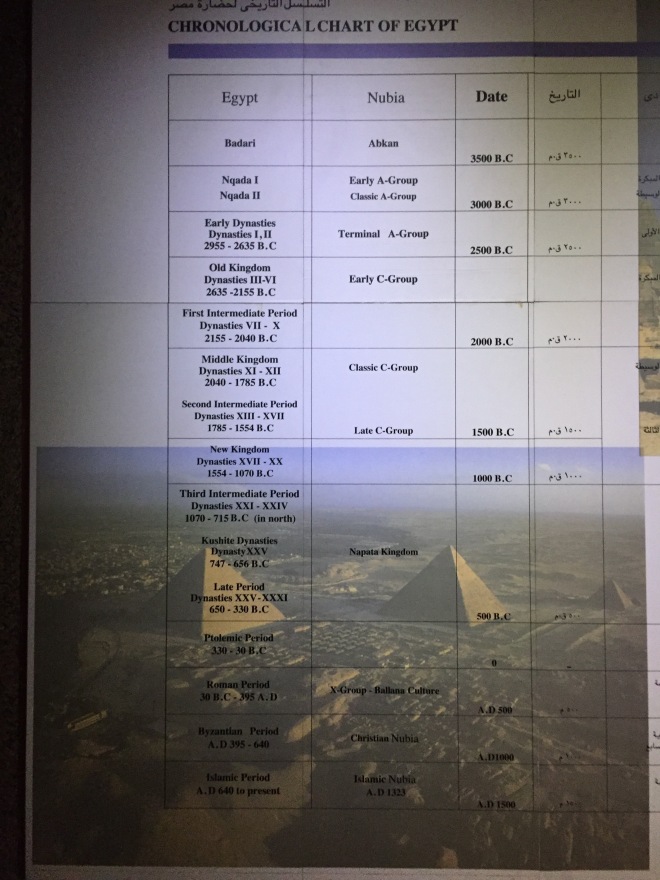
We landed in Cairo a week ago, and were welcomed by our dear friend Hanan, who stayed with us in Minneapolis six years ago when she was on a journalism fellowship in Minnesota. Though inexperienced with canines, she bravely soldiered on at our two-dog house.
The next day, Hanan took us to some Coptic churches in Cairo, where we learned that Coptic once upon a time simply meant Egyptian to the newly-arrived Arab rulers in the 7th century. Pretty much all Egyptians were Christian, part of the Eastern Orthodox world. Later, Coptic came to mean Non-Muslim, therefore Christian. Coptic churches are some of the oldest in Christendom. They have their own Pope based in Alexandria. In one of the churches we saw this well (below) where Jesus, Mary, and Joseph may have lived during their time as refugees in Egypt.
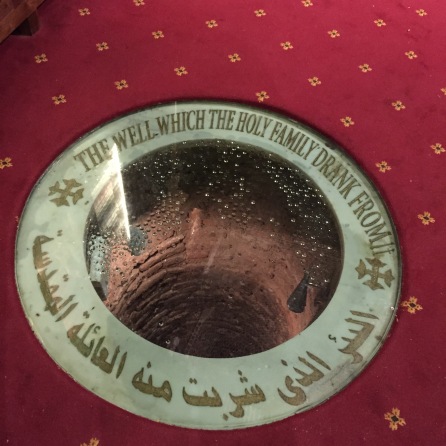
In that same church, we saw this portrait of St. Paul, whose book is in Arabic, though he wrote his letters in Greek. Without Paul, the faith of Jesus might have simply remained one of many variations of Judaism during the first century.
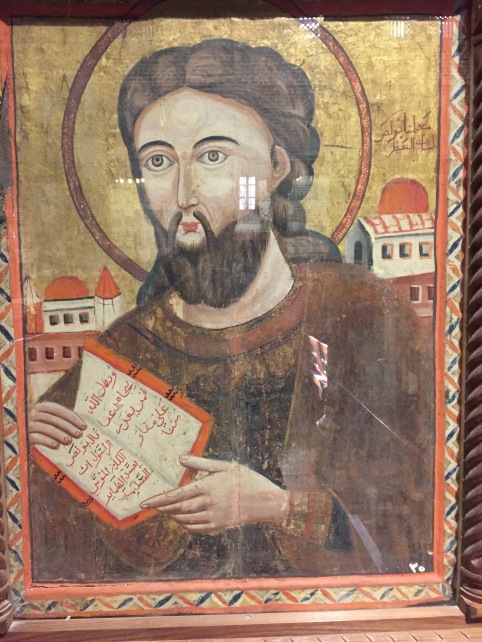 I will be writing more about this soon, but in the early years of Christianity it wasn’t clear whether the Jerusalem-based Jewish Church or the many Gentile churches in Greece, Asia Minor, Syria, and Egypt would eventually predominate. Jesus’ younger brother James headed the Jewish Church, and others, most notably Paul, led the others. I know “Jewish” and “Church” don’t sound right together, and eventually that contradiction doomed it. Fellow Jews said they weren’t really Jewish because of their belief in Jesus as Messiah (but not Son of God) and fellow Christians said they were not really Christian for the same reason. As it turned out, Gentile Christianity took over as Christianity became a World Religion. The Graeco-Roman World was so much bigger than the Jewish world. In the first decades after Jesus, the Hellenized faith of Paul spread to cities all over the Roman Empire, while what we might call the Jewish Church in the Holy Land and parts of the Near East grew much more slowly, and eventually disappeared, though its ideas were (perhaps) resurrected a few centuries later in the Qur’an. But that’s a story for a future post.
I will be writing more about this soon, but in the early years of Christianity it wasn’t clear whether the Jerusalem-based Jewish Church or the many Gentile churches in Greece, Asia Minor, Syria, and Egypt would eventually predominate. Jesus’ younger brother James headed the Jewish Church, and others, most notably Paul, led the others. I know “Jewish” and “Church” don’t sound right together, and eventually that contradiction doomed it. Fellow Jews said they weren’t really Jewish because of their belief in Jesus as Messiah (but not Son of God) and fellow Christians said they were not really Christian for the same reason. As it turned out, Gentile Christianity took over as Christianity became a World Religion. The Graeco-Roman World was so much bigger than the Jewish world. In the first decades after Jesus, the Hellenized faith of Paul spread to cities all over the Roman Empire, while what we might call the Jewish Church in the Holy Land and parts of the Near East grew much more slowly, and eventually disappeared, though its ideas were (perhaps) resurrected a few centuries later in the Qur’an. But that’s a story for a future post.
St. Paul’s genius, as Lynnell and I have several times taught in Sunday School back home, was his multicultural, universalist vision of Jesus as the Incarnation (a Greek idea) of The One God (a Jewish idea). Egypt was, at the time of Paul, a thoroughly Hellenized country, with a very long history of polytheism recalled (below) by these gods in the Egyptian Museum in Cairo. Some were Greek imports, and others home-grown Egyptian gods.
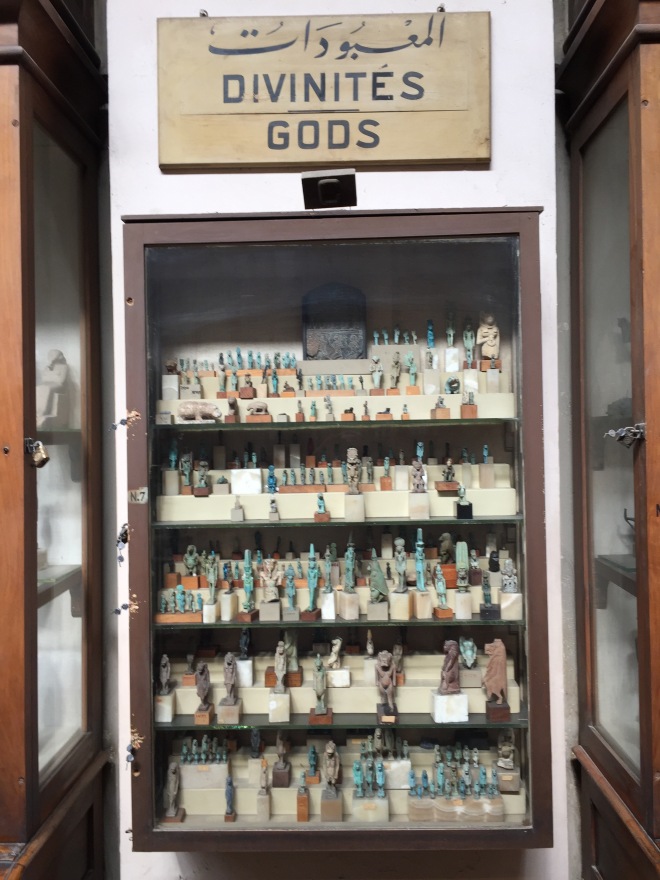
The next morning, I walked up the street to St. John The Baptist Anglican Church, which turned out, by happy coincidence, to be the church where my friend Paul-Gordon Chandler had been rector until a few years ago. He is the author of a 2008 book about Muslim followers of Jesus, Pilgrims of Christ on the Muslim Road, which is even timelier now than ever. I will be teaching a new course at Breck in the fall, if I get enough interested students, called The Islamic World, which will include some extracts from Paul-Gordon’s work.
The Anglicans have their most important weekly service at St. John’s Church on Friday, so I had already missed it. They host a half dozen other groups, though, including a Sudanese congregation that doesn’t have a building, so I figured I would recognize the various stages of the mass, as I had in Malayalam in India and Catalan in Spain. I chatted before the service with a young youth pastor named David whose parents immigrated from Sudan to Australia. He was in Cairo hoping to learn more about different Christian approaches to community-building and pastoral care.
The service was not Anglican, as it turned out, but charismatic, which meant they would start out with at least ninety minutes so of music, all in a South Sudanese language, interspersed with prayers. The keyboard player was a young man, as was the main preacher, but the leader was a young woman, as were the singers, and an older woman (below) got up from the front row and passionately addressed everyone for awhile. Having seen only male religious leaders in India, Morocco, Spain, the Canaries, and France, I smiled. The service continued long after I slipped out.

The next day, we got to see several important mosques in Cairo. I took the picture below in the mosque dedicated to honor Muhammad’s grandson Hussain whose murder made permanent the growing Sunni-Shia split in the year 680. The man in the photo below is remembering Hussain at the silver door of his shrine. Later, I got to watch a teacher talking to a group of young men. What looks like a scoreboard on the left is a display of the five prayer times for that day. Times vary according to when sunset and sunrise happen.

While we had been a bit dismayed not to have been able to enter any mosques in Morocco except for the internationally-famous Hassan II mosque, in both India and Egypt, we’ve been warmly welcomed as long as we had modest clothing and took our shoes off. In fact, two young men from Marhaba (“Welcome!” in Arabic) gave us brochures and some explanations of the basic features of the al-Fustat mosque in Cairo. Al-Fustat is one of the oldest mosques in the world. In the picture below, Hanan and Lynnell stand in the courtyard in front of the washing-up pavilion just before sunset prayers were to begin.

As it happened, one of the people who greeted me turned out, five minutes later, to be the leader for sunset prayers. As he took the microphone and began to chant the call to prayer, he caught my eye and winked as if to say, ‘yeah, that was me, I didn’t think you knew that.’ His beautiful baritone voice echoed off the marble surfaces. Lynnell and I retired to the back to pray in our own way. About halfway through the brief service, a group hurried in with a casket, and maybe fifty mourners on the men’s side joined the shoulder-to-shoulder line of prayers. After the service they hurried out. Hanan told us they would bury their relative right away, at a cemetery not too far away.
The next day, we also got to enter the mosque at al-Azhar University, the most revered center of learning in Sunni Islam. The people there, once again, were happy to have us, though they gave Lynnell an elastic-waist skirt to pull over her jeans.
One of my favorite moments came later on, in a Coptic Christian Church. A group of American pilgrims had been sitting attentively, listening to an Egyptian guide. I thought were Mennonite, but they were German Baptist (man, there are a lot of Christian denominations!). At the end of the guide’s explanation, one of the men, bearded without moustache à la Abraham Lincoln or the Amish, stood up and thanked their Egyptian hosts. Then he invited his fellow Americans to sing a prayer of thanks for their Coptic brothers and sisters, and the four-part “Alleluia” filled the fifteen-hundred year old sanctuary with the sound of love and friendship.
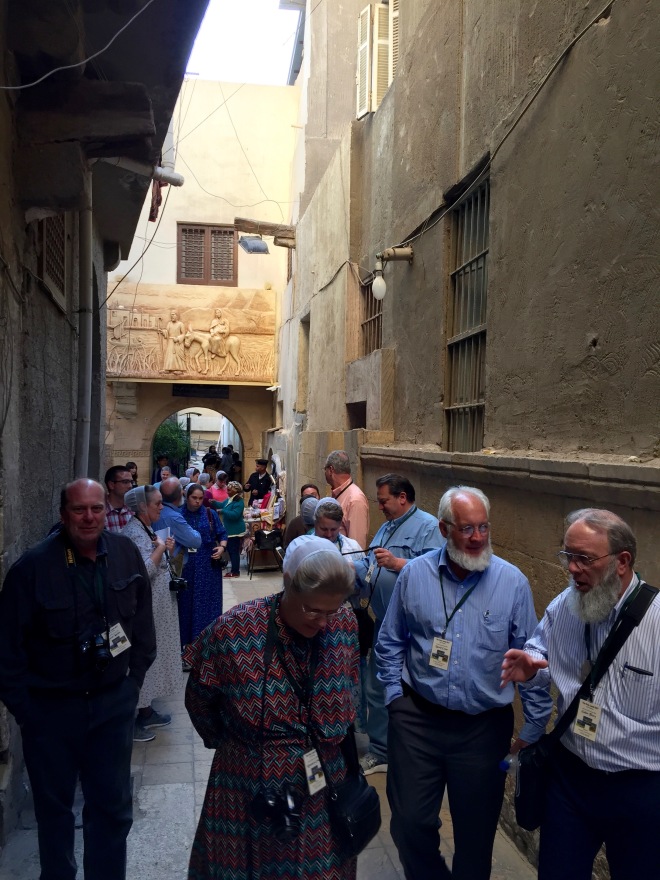
Here’s a picture of a small altar in that church. The icon in the background is Greek, from the 1800’s, and the fresco on the wall is a much older depiction of a saint.
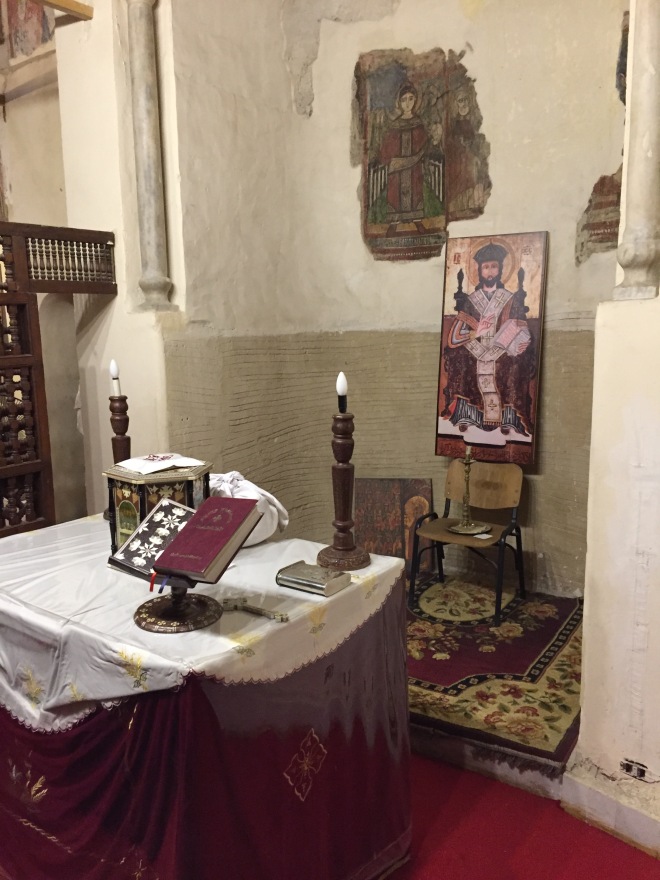
Here’s one last picture from Cairo, a stone relief of the Pharaoh Akhnaten, the lone monotheist in a long line of polytheistic Egyptian monarchs who were happy to count themselves among the gods. He was married to Nefertiti, and died in 1336 BC. He’s worshipping the One True God, symbolized by the orb of the son. It’s just one of the great things we saw in the Egyptian Museum off Tahrir Square in Cairo. The display cases are all wood and glass and the index card explanations were typed, rather than printed, but who cares? Egypt is so stunningly old that the last XC or C years don’t really count.
